
|   |

|   |
 e-mail: leelakaverivenkat@gmail.com Moham and performances for Independence Day August 27, 2024 RAGINI'S BHARATANATAM RAPTURE CAPTURES ALLURING POWER OF MOHAM Performing after a fair gap in the capital, Ragini Chandershekar's Bharatanatyam recital at the Deshmukh auditorium, under the banner of Kalangan, displayed the power and depth of dance proficiency stemming from family inheritance, and the ambience of music and dance she grew up in. As Jamuna Krishnan's daughter / student, honed right from childhood with training under the best of Gurus - K.J. Govindarajan, K.N. Dakshinamurty, Kalanidhi Narayanan and Usha Krishnamurty, Ragini has been performing for over forty years. Heading Kalangan ever since Jamuna Krishnan's absence, the dancer would seem to have single mindedly further enhanced her music / dance, knowhow and performance. Thematically fashioned round 'Moham' or Desire born out of that inexplicable attraction between two entities, Ragini's straightforward, clean and orthodox Bharatanatyam recital came as a relief, after the rather eccentric happenings surrounding the dance scene in recent days. 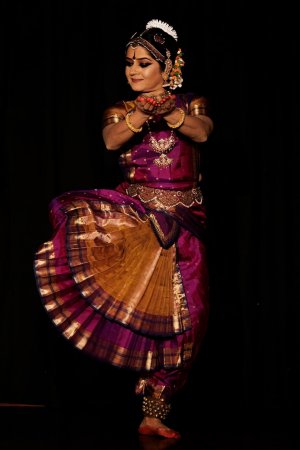 Ragini Chandershekar (Photo: Innee Singh) Ragini began her dance search into Moham, with a brief Pushpanjali, followed by a Dasarapada set to ragam Mohanam. The devotee in this composition is ensnared by Udupi Krishna, wondering about his smiling visage, while knowing full well, this poor devotee's trials in this Ocean of Suffering which is the Universe. Right from the short and melodious alap on flute by G. Raghuraman, and the deeply involved, lustrous singing of Sudha Raghuraman, one realized that this was going to be a specially rewarding evening. In the centrepiece of the varnam Mohamaginen inda velaiyil in raga Karaharapriya, a stellar composition of Guru K.N. Dandayudapani Pillai, which Ragini learnt from Usha Krishnamurty who had been taught this Varman by the great master himself, Ragini was wise enough to preserve the jatis as composed by the Guru himself. In the passages describing the ensnared Nayika's feelings for the Lord of Chidambaram, Ragini's sanchari portraying the smitten Nayika was built round the Purush/Prakriti contrasts - the Nayika doing her sringar reminded of the complementing opposites of her long tresses and hairdo against Shiva's curling, matted locks, the ornaments draping her neck against his snake garland, her forehead with the vermilion mark against his powerful third eye - and her flowing garments against Shiva's tiger skin clad body. 'Will he come?' she wonders, demanding from the sakhi, why she is hesitating at this moment to carry her message of love, when she is swept by tides of longing, with the moon out and the time just right for lovers to be together. A forty minute marathon presentation, immaculate in rhythm, body technique, and dance line, the varnam was embellished with Sudha Raghuraman's evocative vocal support with Varun Rajashekharan's nattvangam and M.V. Chandershekar on the mridangam. The post varnam abhinaya part had a rare mix of compositions from languages, not always part of a Bharatanatyam recital, thanks to Ragini's mother Jamuna Krishnan's research into Dance Poetics in a big way, dealing with Hindi literature like the Sursagar and poetry of Vidyapati. Armed with her equal depth in classical music, she was able to set the chosen bits of poetry into music, also composed by her - and the products of her work form a treasured part of Ragini's Bharatanatyam repertoire. The first abhinaya offer pertained to a ninda stuti from Sursagar, wherein the heroine who has lost her heart to Krishna, acknowledges the one-sided desire never reciprocated, for anyone who sets her heart on Shyam. Set to raga Piloo, Sada hi aise (It has always been so) admits the nayika. Like the Chakora bird's pointless yearning for the moon, or the Jataka watching the clouds eagerly, thirsting for the rains, while the uncaring clouds empty their water elsewhere, or like the waters of the river uncaringly washing away the fish that live in it, the feelings cherished for Shyam are doomed to remain unreciprocated. The next mimetic number, a Javali in Kamas, a composition of the 19th century Patnam Subramani Aiyer, Appudu manasu nilusunade aivaroyedeti mata, wherein the gauche mugdha Nayika, untried in the ways of love, asks if it is reasonable to expect her to lock her heart and still the mind without responding when the eyes accost a beautiful man. The last of the interpretative offers saw a khanditha who has seen it all, and orders the two timing lover not to touch her, Mohe chuo jani, door raho. Set to raga Abhogi, the Nayika while spitting anger and hurt pride walks away - even as her heart is unable to wipe out her love for the man. The dancer concluded on the same faultless note with Lalgudi Jayaraman's Tillana in Tilang. SWARNA SAROJA Time and tide wait for no man and soon after the mortal remains of legend Yamini Krishnamurti being consigned to flames, dance lovers entering the portals of Ganesa Natyalaya for the Swarna Saroja evening for Padma Subrahmanyam's lecture on the Natya Sastra, was for this critic, a pointer to the reality of life that marches on with arrivals and departures. 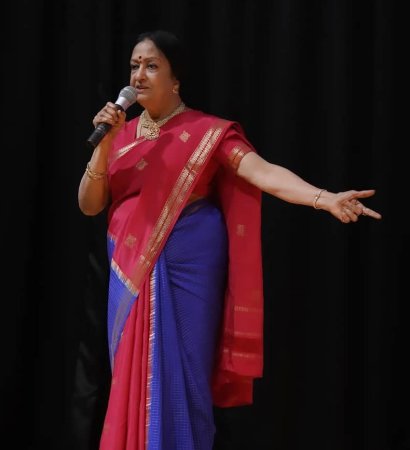 Padma Subrahmanyam After a suitable homage to the departed soul, Padma Subrahmanyam's lecture with demonstrations by student/niece Mahati Kannan with a Masters degree in Arts, and nattuvangam and singing by Mahati's mother Dr. Gayatri Kannan, herself a PHD in Sanskrit, demonstrates how tradition is assured of a continuity, with a whole family involved in various aspects of dance research. Padma's research into the Natya Sastra and the Karanas is now a part of dance history - providing yeoman service in understanding the evolution of movement in Indian dance, so profusely illustrated in temple sculpture of the country, its influence seen in Jambudweepa - in temples outside India too like the Prambanan temple. Besides, so vast is the knowledge compendium contained in the Natya Sastra that what Bharata created is Natya Veda encompassing all the elements of theatre art. What took a whole decade of painstaking research by Padma is now part of dance pedagogy and both these aspects of theory and practice are thanks to Padma's efforts. Reconstructing each part of what was lost technique in history, meant also a detailed study of Abhinava Bharati, Abhinavagupta's commentary of the Natya Sastra without which it was impossible to understand Bharata's text. It was in 1963 that Padma established the fact that Karanas depicted on temple walls, with the couplet from the Natya Sastra engraved below (famous Brihadeeswara Temple or Periya Koil in Thanjavur) - though here too all 108 Karana are not complete - were not static poses, but frozen moments from units of movements comprising sthana, chari and nrttahasta (Hastapada Samayogah nrttasya Karanam bhavet). Also established by Padma and stressed by her in the lecture, was the fact that Karanas were not the prerogative of any one style of Indian dance. The Angas (major limbs of body), Upangas (minor limbs of body) are all involved in a Karana. 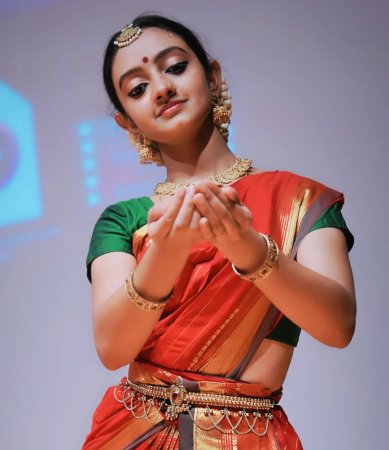 Mahati Kannan For the demonstration part was Mahati Kannan with her supple, almost boneless ability to move. Movements of Bhoomi Charis and Akashachari, and the correct method of executing Karanas like Apakrantha (wherein the thighs have to be in touch with each other), Vidyut bhrantam (wherein the left foot in kunchita is crossed at the back and right foot suggests the beginning of being lifted), Gaja Kriditakam (wherein the left hand is near the forehead and not near the ear) ,were shown. Referring to the graceful and more forceful movements Padma mentioned that these were termed Uddata and Sukumara or tandava and lasya. The speaker spoke of the very first Talapushpaputa Karana which comes into play in the starting Pushpanjali. Two compositions choreographed by Padma Subrahmanyam were presented by Mahati. The first was Kalinga nartanam based on Melattur Narayana Bhattadri's Narayaneeyam. The concluding item was Jatayu Moksham based on Tchaikovsky's music comprising an overture from Romeo and Juliet, which was received with rapturous applause in the Soviet Union when first presented by Padma. Needless to say, Mahati's performance was both involved and movement perfect to the last degree. The mixed audience of students of dance and adults found the evening both informative and regaling. HONOURING ART RELATED PERSONALITIES AND SHOWCASING VARIETY OF INDIA IN TIRANGA Supported by Ministry of Culture and the Habitat, Odissi exponent Ranjana Gauhar's Utsav held its annual two-day, handsomely attended festival Sare Jaahan Se Achha, at the Stein auditorium of Habitat. Several dance related personalities encompassing dancers, art sponsors, art bureaucrats, music composers, dance writers, not excluding costume and jewellery designers et al were honoured before the dance presentation started, both days. While the performance calendar, for the first evening, featured dancers of Utsav only, the second evening, starting with a short presentation by the hosts, featured Bharatanatyam, Manipuri and Kathak in that order. Chandrabhaga presented by Utsav dancers on the first evening, is based on an old tale of Chandrabhaga playing on the sands of the beach when Kamadev, in his usual mischievous fashion aims his love darts at Surya, who developing a passion for Chandrabhaga chases her, as she plunges into the sea in the attempt to escape his clutches. With music provided by Suren Mohanty, Ranjana Gauhar's choreography with pure dance passages from Pallavi knitted in-between sahitya passages as presented by her students, had its best dancer in Vrinda Chadha, who as Chandrabhaga displayed both grace and mimetic qualities. In the role of the sun was her loyal student, Vinod Kevin Bachan. The corps dancers, still young students, while showing fair group discipline, have still some way to go. The next group presentation was built round Matsya avatar, portraying the story of Lord Vishnu incarnating as a fish, to rescue the Vedas written by Brahma, stolen by the demon Hayagriva, son of Kashyapa and Diti, and hidden in the depths of the Ocean. The choreography, again with nritta passages from known traditional pieces like Trikhandi pranam woven in, for this critic, needed a more expanded vocabulary of movements. But again it was Vrinda Chadha appearing as Vishnu/Krishna who shone. The Bismillah Khan SNA award which has come the way of lesser dancers, has surprisingly, so far ignored her. The demon in a short appearance in the form of a Mayurbhanj Chhau dancer was convincing, for the expanse of the style came as a contrast to the Odissi grace. But the lines from Vishnu Sahasra namam (Paritraanaaya saadhoonaam, vinaashaaya dushkrtam, dharma sansthapanaarthaaya sambhavaami yuge yuge) being danced by the demon was surprising to say the least - for the words of being born again and again in different avatars to save mankind whenever evil overpowers, to reestablish the power of good, is the prophecy uttered by the God himself and not the demon. The next evening's Utsav presentation was a short production Raas Rang - the Dance in the Forest based on the vision of a devotee, who as Sutradhar visualizes Krishna dancing in joy in the forest with the birds, deer and peacock, and then, hearing the anklets of Radha, he searches for her, and when their eyes meet, Radha and Krishna engage in a joyous dance of Raas. Based on an Oriya dance drama, which in the Sabhinaya form is a blend of nritta and interpretative dance, it is built round the joy of the devotees. On festive occasions, devotees carrying the Gods on their shoulders, the bhaktas, express their deep desire to have a glimpse of this exotic dance in the Kunja. During the high festive spirit of Holi, Radha and Krishna are visualized together throwing colour on each other, dancing. Choreographed by Ranjana with Vinod Kevin Bachan as assistant, the script with Sanskrit and Odiya lyrics by Nabakishore Mishra, has music composed by Sukant Kundu with rhythmic input by Dhaneswar Swain. The main dancers comprised Vinod Kevin as Sutradhar, Vrinda Chadha as Krishna, with Archisha Arya as Radha. Swati Sharma, Urjaswi Dutt and Lavanya Chugh were the Gopis. Bharatanatyam steals the show 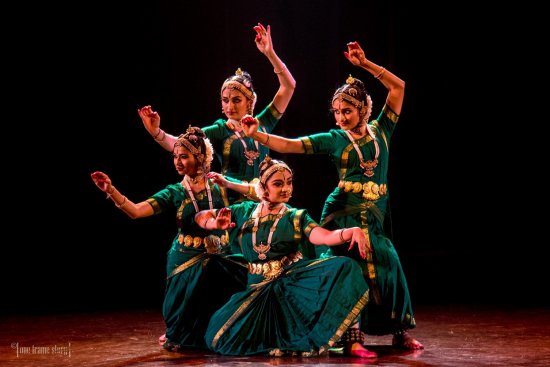 Sandhya Purecha's disciples (Photo: One Frame Story) Like a sunshine burst, were the Bharatanatyam dancers, all students of Bharata College of Fine Arts and Culture, established with the hard work of Sandhya Purecha, Chairman of the Sangeet Natak Akademi. Trim and aesthetically turned out in an all green costume, the four dancers, right from the opening item, a tribute to Shiva - Bho Shambho in raga Revati, revealed impeccably trained bodies. The choreography had knit in all the seven types of Tandava dance mentioned in Svanidhi of Sri Tattva Nidhi namely Ananda Tandava, Sandhya Tandava, Uma Tandava, Gauri Tandava, Tripura Tandava, Kalika Tandava and Samhara Tandava. The poses held in rock steady balance of Yoga trained bodies, were a delight to see. The araimandi, the leg stretches, the hand movements - every aspect from the way the body was held to the unified movements, it was a joy to see such a finished performance. The next item was based on an Abhang, paying homage to Pandurangi of Pandaripura. And in the finale of Vande Mataram, fitting it with the occasion of the Independence Day celebration, one got glimpses of Sukha lasya which Padma Subrahmanyam's Bharatanrithyam specializes in. It was an exhibition of both grace and vigour, and mimetic subtlety that one received from the dancers. The four Bharatanatyam dancers were Chitra Devi, Suhani Dhanki, Ushmi Doshi and Sanika Shinde. Manipuri at its best by disciples of Shyam Singh 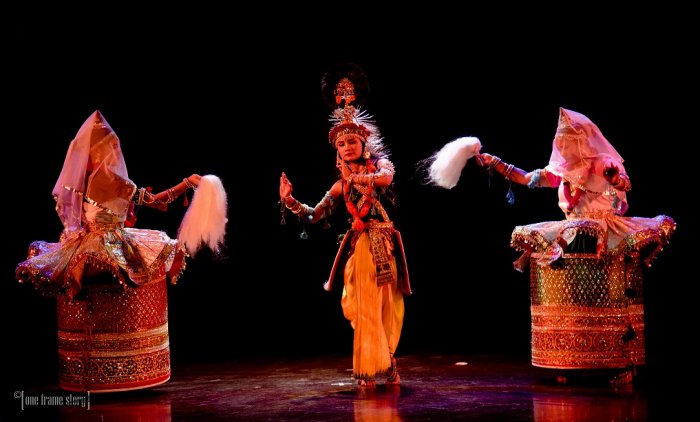 Manipuri Vasant Raas (Photo: One Frame Story) Manipuri dancers are always a very disciplined lot, and it was no different in the case of Shyam Singh's troupe. Starting with the combined grace of light footed jumps while simultaneously playing on the percussive melody of the Pung slung round the neck to fall at waist level, were the competent Pung Cholam performers, followed by the contrasting soft grace of female dancers with feet never lifted in high jumps, in Vasant Ras, the gorgeously costumed dancers representing Krishna, Radha and a Gopi. The taped music had the most delightful singing in typical Manipuri style. The lively finale was provided by Dhol Cholam, and its acrobatic jumps executed while playing the instrument. The entire troupe comprised Khoibi, Kaushal, Priyakanta, Khambaton, Emoinu, Sapana and Kamala. To round off a varied evening's fare was a short Kathak recital Kesariya Bharat visualized by Sangita Chatterjee, presented by her with her students Kavita Das, Lisa Saha, Binati Arora and Pratiksha Guru. In keeping with the occasion, the concept by Sangita knit together several ideas in a harmony embodying the essence of Bha-ra-ta - namely Suryakant Tripathi Nirala's Bharat Vandana, wherein the poet personifies Bharat as Goddess Saraswati embodying wisdom of knowledge and philosophy, the fervour of nationality with the head held high, ringing in words of Tagore, the three syllables of Bharata standing for Bhava, Raga and Tala celebrating the harmony of diverse cultures living and marching in unity of rhythm, the tones of which are contained in raga Desh. Helping to form a tapestry of all these ideas in a smooth continuity, was the music by Anirbhan Bhattacharya, with Sangita's dance choreography. There was a lot of play on words, using the saffron on the fluttering flag, the Kamala / Komala Hridaya, the omkara of Prana, Bhaje Bhaje Sargam Bhaje - all of which was in keeping with celebrating the Independence Day. Altogether a well-planned festival!  Writing on the dance scene for the last forty years, Leela Venkataraman's incisive comments on performances of all dance forms, participation in dance discussions both in India and abroad, and as a regular contributor to Hindu Friday Review, journals like Sruti and Nartanam, makes her voice respected for its balanced critiquing. She is the author of several books like Indian Classical dance: Tradition in Transition, Classical Dance in India and Indian Classical dance: The Renaissance and Beyond. Post your comments Pl provide your name and email id along with your comment. All appropriate comments posted with name and email id in the blog will also be featured in the site. |